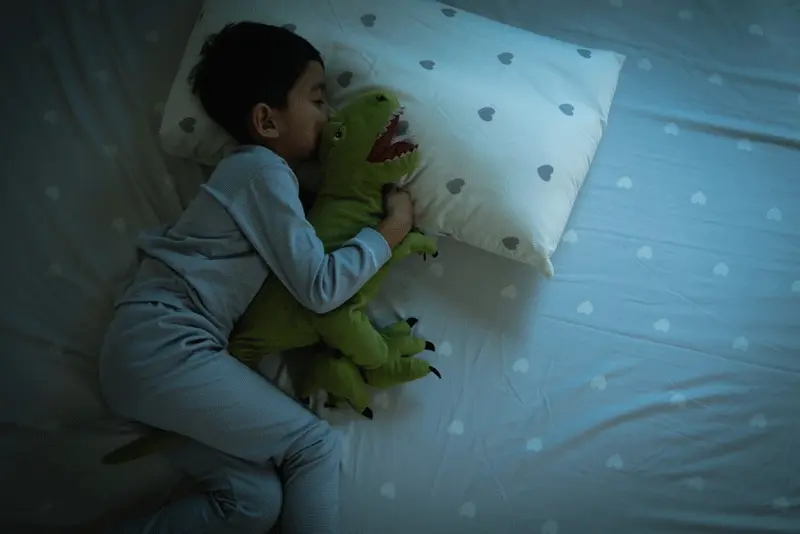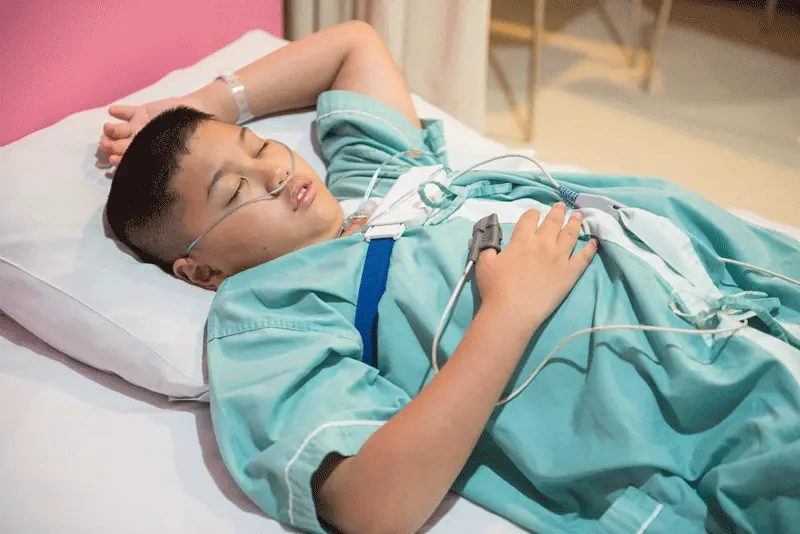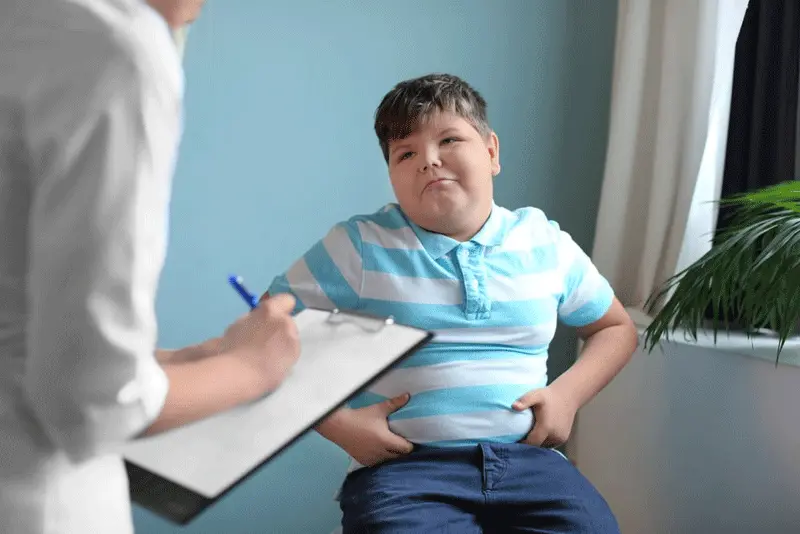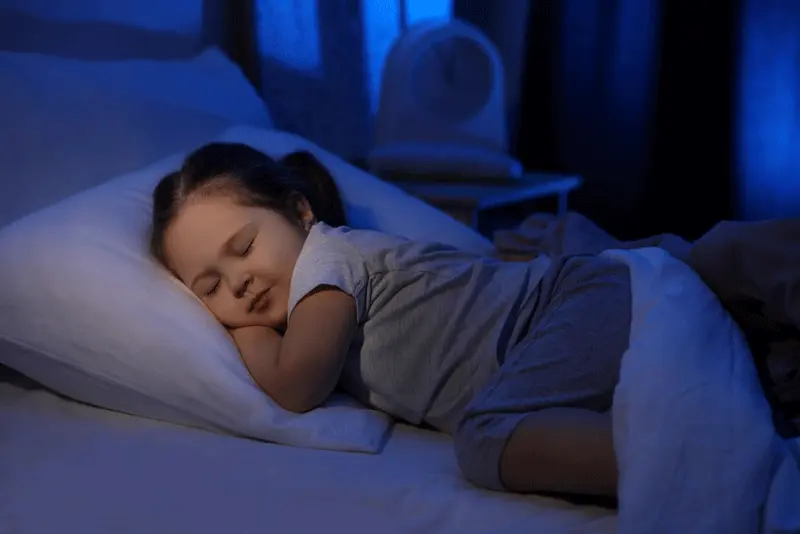Sleep Apnea in Children: The Best Sleeping Position for a Better Night's Rest
Jul 11th 2023
Imagine your child's beloved teddy bear, Mr. Snuggles. Soft, comforting...and with an essential role in your child's sleep routine. Now, think of the sleep position as an invisible version of Mr. Snuggles—an unseen companion that can make significant differences in your child's sleep quality, particularly for kids with sleep apnea. Just as each child has a preferred cuddle toy, they also have a beneficial sleeping position that can aid in their battle against sleep apnea. The question is: have you found the right one for your little one? Tune in to uncover how certain sleeping positions can help alleviate symptoms of Sleep Apnea in children for a healthier and well-rested dawn.
According to experts, side sleeping is the best sleeping position for children with sleep apnea. This helps keep the airways open and prevent obstructions that can lead to breathing difficulties during sleep. Parents should consult with their healthcare provider to determine the best position and treatment plan for their child's sleep apnea.
Understanding Sleep Apnea in Children

Sleep apnea is a sleep disorder that affects people of all ages, including children. It occurs when breathing stops and starts during sleep, disrupting the normal sleeping patterns of the individual. Obstructive Sleep Apnea (OSA) is the most common type of sleep apnea in children. OSA occurs when air cannot flow in and out of the nose and mouth during sleep, resulting in loud snoring or choking sounds.
There are many risk factors that can lead to sleep apnea in children. Common causes include obesity, enlarged tonsils or adenoids, chronic nasal congestion from allergies or other respiratory issues, neurological or muscular disorders, and craniofacial abnormalities such as a small jaw or large tongue. The symptoms of sleep apnea in children can vary widely, but include daytime fatigue, irritability, poor concentration, mood swings, difficulty concentrating and hyperactivity.
Those with personal experiences often narrate how their children became suddenly irritable during daytime activities which later escalated into total lack of concentration and even depression. A friend of mine recounted how his son always had bags under his eyes and wasn't getting enough restful sleeps until he visited an outpatient clinic only to find out the root cause was sleep apnea.
It is important to diagnose and treat sleep apnea in children as it can impact their overall quality of life. Untreated OSA can interfere with physical growth, cognitive development, academic performance and behavior.
One study found that sleep apnea may negatively impact neurocognitive function in children with attention-deficit/hyperactivity disorder (ADHD). Researchers found that children with ADHD who had untreated OSA had lower scores on tests for attention span, decision-making abilities and working memory than those without OSA. This highlights the importance of treating OSA in children to improve overall cognitive function.
However, some argue that mild cases of sleep apnea in children may not require treatment. Some children may outgrow OSA as they age, and treatment such as surgery or continuous positive airway pressure (CPAP) therapy may not be necessary. It is important to consult with a healthcare professional to determine the severity of the condition and appropriate treatment plan. Sleep apnea is a sleep disorder that can affect children of all ages and should not be overlooked. With the potential to interfere with physical growth, cognitive development, academic performance, and behavior, it is important for parents or caregivers to recognize the symptoms and seek medical attention. While some mild cases may not require treatment, consulting with a healthcare professional can help determine the best course of action to improve overall cognitive function and quality of life.
Optimal Sleep Positions for Kids with Sleep Apnea
Sleep position can play a significant role in managing sleep apnea in children. Studies have shown that changing sleeping positions can help decrease symptoms of sleep apnea and improve overall sleep quality.
The Benefits of Side Sleeping Experts recommend side sleeping as the best position for sleep apnea in both obstructive and central sleep apnea. Side sleeping helps to keep the airways open by allowing the tongue and soft tissues around it to fall forward and not obstruct breathing. In particular, sleeping on the left side may further reduce symptoms as it positions the heart above the stomach, reducing reflux which can exacerbate symptoms.
Think of your child's windpipe as a garden hose; when there is no water coming out of it, it's easy to manipulate any way you want, right? But when water flows through it under pressure, you have less control over its shape. Similarly, during sleep your child's relaxed body tissues can begin to sag down towards their throat making it more narrow and harder to breathe through; but laying them sideways makes gravity work against this sagging.
Dangers of Back Sleeping Back sleeping is identified as the worst position for sleep apnea because gravity forces the tongue and soft tissues backward, blocking airflow in the airways and worsening symptoms. More than half of people with OSA experience more severe symptoms when sleeping on their back.
It is crucial for parents to encourage their children to avoid back sleeping to manage sleep apnea symptoms. A simple trick for younger children could be to place a pillow or stuffed toy behind their back, making back-sleeping an uncomfortable option.
The Benefits of Side Sleeping

When it comes to children with sleep apnea, the position they sleep in can make a significant impact on their quality of sleep. According to sleep experts, side sleeping is the best position for children with sleep apnea. There are many benefits that come along with this position, including improved breathing and reduced symptoms.
Anecdotal evidence shows that many parents notice changes in their child's behavior after switching to side sleeping. They report that their child is less irritable during the day and has an easier time focusing and completing tasks. This is because side sleeping allows for better oxygen flow to the brain, which means that children wake up feeling more refreshed and alert.
Research supports this claim. A study published in Pediatric Pulmonology found that side sleeping significantly improved symptoms of sleep apnea in children. Another study showed that side sleeping led to a decrease in snoring and improvement in oxygen saturation levels during sleep.
Of course, some parents may be hesitant to switch their child's sleeping position, especially if they have been back sleepers since infancy. However, it is important to remember that the benefits of side sleeping cannot be ignored. In fact, the American Academy of Pediatrics recommends that infants be placed on their backs to reduce their risk of Sudden Infant Death Syndrome (SIDS), but after 1 year old when this risk has decreased, they can start side or stomach sleeping.
Think of it like exercising a muscle; if you use it consistently in one way only, it will eventually become weak and strained. Switching up your child's sleeping position can give different muscles in their bodies a chance to work properly, leading to better breathing and more restful sleep.
With all of these benefits in mind, it's clear why side sleeping should be considered as the optimal sleep position for children with sleep apnea. But what about other sleeping positions? Let's explore the dangers of back sleeping.
Dangers of Back Sleeping

While back sleeping may be comfortable for many people, it can actually have negative effects on children with sleep apnea. It is important for parents to understand the risks associated with this position and take steps to avoid it whenever possible.
Studies have shown that more than half of people with OSA experience more severe symptoms when sleeping on their back. This is because the tongue and soft tissues in the back of the throat are more likely to collapse and block the airway in this position, leading to episodes of apnea.
One parent shared their story about how they noticed their child's snoring and breathing difficulties were worse when they slept on their back. When they switched to side sleeping, these issues disappeared almost instantly.
However, some parents may still wonder if back sleeping is really that dangerous. After all, it can be a difficult habit to break. But it is essential for parents to understand that even if their child does not have an official diagnosis of sleep apnea, back sleeping can still pose a risk to their health. Not only does it worsen symptoms such as snoring and mouth breathing, but it also increases the risk of developing sleep-disordered breathing over time.
Think of it like standing on one foot; you may feel steady at first, but staying in that position for too long can cause strain and imbalance throughout your entire body. According to the American Academy of Sleep Medicine, Obstructive Sleep Apnea (OSA) affects approximately 2-3% of children in the general population. A study published in the Journal of Clinical Sleep Medicine found that more than 60% OSA patients experience more severe symptoms when sleeping on their back. Research from the American Thoracic Society showed that side sleeping can reduce apnea-hypopnea index (AHI) scores by up to 50% compared to back sleeping among pediatric sleep apnea patients.
Supplementary Strategies for Managing Sleep Apnea
Aside from positional therapy, there are several other strategies parents can employ to alleviate symptoms of sleep apnea in children. In fact, combining these strategies with optimal sleep positions may provide the best results for children with sleep apnea.
First and foremost, maintaining a healthy weight is crucial for managing sleep apnea symptoms. Obesity is one of the top risk factors for obstructive sleep apnea (OSA) in both adults and children. Excess body weight can put pressure on the airway, leading to partial or complete blockage during sleep.

Think of it this way: imagine a straw that's being squeezed by a tight rubber band. The more you add pressure by squeezing the band, the harder it becomes to suck air through the straw. Similarly, excess body weight puts pressure on the airway, making it harder for your child to breathe normally during sleep.
Implementing a nutritious diet and regular exercise routine may be helpful in reducing body weight and thereby improving symptoms of sleep apnea in children. While it may be challenging to get kids to form healthier habits at first, slowly introducing new healthy foods and outdoor activities such as biking and hiking may lead to long-term success.
Another beneficial strategy is reducing exposure to allergens and irritants. Allergies and asthma can exacerbate symptoms of sleep apnea in children. Parents can improve indoor air quality by using an air purifier or avoiding common asthma triggers like pet dander, dust mites, and pollen.
Some parents may turn to over-the-counter medications for allergy relief but should always consult with their healthcare provider before giving any medication to their child. Some allergy medications can have side effects like drowsiness, which could worsen symptoms of sleep apnea. Discussing lifestyle changes and medical treatment options with a healthcare professional can provide the best guidance for reducing symptoms of sleep apnea in children.
Lastly, practicing good sleep hygiene by establishing a regular bedtime routine can benefit children with sleep apnea. A consistent sleep schedule helps regulate the body's internal clock, leading to more restful and restorative sleep. Parents should aim to create a calm and soothing sleep environment, free from technological distractions like TV, tablets, and smartphones before bedtime.
While it may be tempting for parents to allow their child to use screens as a calming mechanism before bed, the blue light emitted from these devices can negatively impact the body's natural circadian rhythm. Overuse of screens has been associated with poor sleep quality and an increased risk of developing sleep disorders. Instead, encourage relaxing activities like reading or soft music before bed for better results.
Importance of Regular Sleep Schedule
Establishing a regular sleep schedule not only helps improve symptoms of sleep apnea but also promotes overall better sleep quality in children. Inconsistent sleep patterns can lead to daytime drowsiness and difficulty concentrating in school.
Sleep is an essential component of growth and development in children. According to the American Academy of Sleep Medicine (AASM), preschoolers (ages 3-5) require 10-13 hours, while school-aged children (ages 6-12) need 9-12 hours of sleep per night.
Implementing a consistent sleep schedule means that kids wake up and go to bed at approximately the same time every day. The key is to establish a routine that works for your family, whether it's waking up early on weekdays or sleeping in later on weekends.
Investing time in creating a healthy sleep environment for your child can pay off dividends in the long run. By sticking to a regular bedtime routine and sleep schedule, your child may experience reduction in symptoms of sleep apnea and enjoy overall better health.
Creating a Comfortable Sleep Environment for Your Child

Creating a comfortable sleep environment is crucial for any child, especially one with sleep apnea. The right sleeping environment can help to promote better quality sleep and decrease the frequency and duration of apneas experienced throughout the night. Here are some strategies you can implement at home to create a more comfortable sleeping environment for your child.
Firstly, pay close attention to the temperature and humidity levels in your child's bedroom. Research has shown that an optimal sleep temperature is between 60 to 67 degrees Fahrenheit. Additionally, maintaining humidity levels between 40 to 60 percent can help to alleviate symptoms related to dry nasal passages or mouth breathing that may occur during sleep.
Think back to your last vacation in a hotel room with blackout curtains. In the morning, you probably woke up feeling rested because the darkness helped you stay asleep through the night. You can create this same environment in your child's bedroom by using blackout curtains or adding white noise machines to block out unwanted sounds.
Another essential factor in creating a comfortable sleep environment is ensuring that your child's bed is supportive enough for their body type. A mattress should provide adequate support and cushioning where needed while keeping the spine in a neutral position. If your child has been using the same mattress for several years or it is no longer providing the support they need, it may be time to invest in a new one.
When it comes to bedding, many parents wonder if they should use cotton or synthetic materials. While both types of bedding have their pros and cons, cotton is often regarded as a more breathable and hypoallergenic option. However, parents should choose bedding that their children find comfortable and suitable for their individual needs.
Additional factors like lighting and screen time before bed can also impact a child's ability to sleep well. Studies have shown that blue light from electronic devices can suppress melatonin production and interfere with sleep quality. To help your child wind down before bed, establish a routine that includes screen-free activities such as reading or stretching.
Creating a comfortable sleeping environment for a child with sleep apnea is an ongoing process, but the tips outlined above provide a good starting point. By taking the necessary steps to optimize your child's sleeping environment, you can help them get a better night's rest and manage their sleep apnea more effectively. Remember that every child is unique, so don't be afraid to try different approaches and consult with your healthcare provider if you need additional support.
Answers to Frequently Asked Questions with Explanations
Are there any risks associated with certain sleeping positions for children with sleep apnea?
Yes, there are several risks associated with certain sleeping positions for children with sleep apnea. The most commonly recommended position for these children is to sleep on their side because it helps keep their airway open and reduces the instances of apneas.
Sleeping on the back, however, can increase the risk of obstructive sleep apnea (OSA) in children. According to a study published in the Journal of Clinical Sleep Medicine, 87% of children with OSA had more frequent events when sleeping on their back compared to only 19% when sleeping in a lateral position.
Moreover, sleeping on the stomach is also not recommended as it can increase the chances of Sudden Infant Death Syndrome (SIDS), especially in infants under 1 year old.
Therefore, it is essential to ensure that children with sleep apnea are sleeping in a safe and recommended position to avoid any potential risks.
What other strategies can be used in addition to adjusting sleep positions to improve symptoms of sleep apnea in children?
While adjusting sleep positions can be an effective strategy to improve sleep apnea symptoms in children, it is not the only method that can be used. Other strategies include weight loss, allergy management, and surgery.
Obesity is a risk factor for sleep apnea in children. A study published in the Journal of Clinical Sleep Medicine found that obese children were more likely to have moderate or severe sleep apnea compared to non-obese children (Katz et al., 2012). Thus, encouraging weight loss through healthy eating habits and regular exercise can potentially alleviate sleep apnea symptoms.
Allergies can also contribute to sleep apnea in children. Addressing allergens such as dust mites and pet dander through allergy management strategies such as air purifiers and allergy shots may improve sleep quality and reduce episodes of sleep apnea (American College of Allergy, Asthma & Immunology).
In certain cases, surgery may be necessary to correct anatomical abnormalities that cause obstructive sleep apnea in children. Research shows that surgical interventions such as adenotonsillectomy can significantly improve sleep apnea symptoms in children (Marcus et al., 2013).
It is important for parents to consult with their child's healthcare provider to determine the best course of treatment for their child's individual needs.
References:
Katz, E. S., Moore, R. H., Rosen, C. L., Mitchell, R. B., Amin, R., Arens, R., & Marcus, C. L. (2012). Growth after adenotonsillectomy for obstructive sleep apnea: an RCT. Pediatrics, 130(3), e476-e482.
American College of Allergy, Asthma & Immunology. (n.d.). Allergy Treatment Types. Retrieved from https://acaai.org/allergies/treatment
How long should a child maintain a certain sleeping position in order to effectively manage their sleep apnea symptoms?
In order to effectively manage their sleep apnea symptoms, a child should maintain a certain sleeping position for the entire night. This could include sleeping on their side or stomach instead of their back, as this can help prevent the tongue and soft tissues at the back of the throat from blocking the airway.
According to recent studies, consistently maintaining a certain sleeping position throughout the night can significantly improve symptoms of sleep apnea in children. In fact, one 2019 study found that children who slept on their sides for at least 70% of the night had a three-fold reduction in symptoms compared to those who only slept on their sides for less than 50% of the night.
Of course, it may take some time for a child to get used to sleeping in a different position. Parents can encourage their child to try different sleep positions and provide comfortable pillows or other supports as needed. Additionally, it's important to note that while changing sleep positions can be helpful for managing sleep apnea symptoms, it should always be done under the guidance of a healthcare professional.
By helping your child maintain a certain sleeping position throughout the night, you can help them get more restful and effective sleep while also reducing symptoms of sleep apnea.
Can the sleeping position for children with sleep apnea vary based on their specific needs?
Yes, the sleeping position for children with sleep apnea can vary based on their specific needs. In fact, it is crucial to identify the ideal sleeping position that will allow for a better night's rest and improve their overall health.
According to studies, sleeping on one's back can exacerbate sleep apnea symptoms as it increases upper airway resistance (Shelton et al., 2015). The American Academy of Pediatrics recommends side sleeping as the best position for children with sleep apnea as it allows gravity to help keep the airway open and decrease the likelihood of disruption during sleep (American Academy of Pediatrics, 2020).
However, it is worth noting that each child's condition and symptoms may differ. Some children may benefit more from sleeping in an elevated position, using pillows or wedges to prop up their upper body. Others may find relief by sleeping on their stomachs or even a combination of positions throughout the night (National Sleep Foundation, 2021).
Therefore, it is essential for parents and healthcare providers to work together to determine the best sleeping position for each child based on their specific needs and circumstances. By doing so, they can help alleviate sleep apnea symptoms and improve their child's quality of life.
Is it possible for proper treatment and management of sleep apnea to eliminate the need for a specific sleeping position altogether?
Yes, proper treatment and management of sleep apnea can eliminate the need for a specific sleeping position altogether. The most common treatment for sleep apnea is continuous positive airway pressure (CPAP) therapy, which involves wearing a mask that delivers pressurized air to keep the airway open during sleep. Other treatments include oral appliances and surgery.
Studies have shown that CPAP therapy significantly reduces symptoms of sleep apnea, including daytime sleepiness and snoring, and improves overall quality of life for both adults and children. In fact, a study published in Pediatric Pulmonology found that CPAP therapy improved sleep architecture and oxygen saturation levels in children with sleep apnea, leading to enhanced cognitive function and behavioral outcomes.
While some children may still benefit from certain sleeping positions as part of their treatment plan, such as sleeping on their side or elevating their head, these recommendations may become unnecessary with successful management of their sleep apnea.
Overall, it is important to work closely with a healthcare provider to determine the best treatment plan for managing sleep apnea in children. With proper treatment, it is possible to eliminate the need for a specific sleeping position and improve overall health outcomes.
